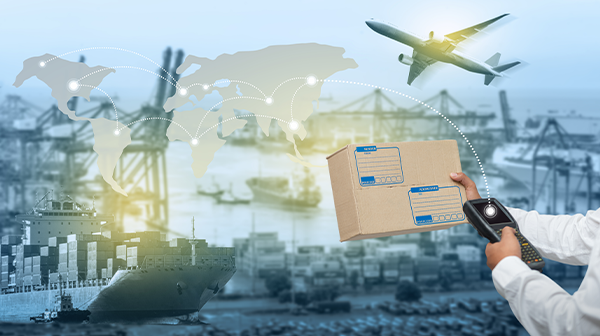Table of contents

Welcome to the first episode of Orchestrating Outcomes, a new video series presented by TraceLink focused on the challenges, opportunities, and impact of supply chain digitalization in life sciences and healthcare. Orchestrating Outcomes features in-depth interviews with leading voices from the worlds of logistics, external manufacturing, direct supply, and much more. Our goal is to share critical insights based on real-world experiences that will help you find success in your organization's supply chain digitalization journey.
In this inaugural episode, Henry Ames, GM of Distribution & Logistics Orchestration at TraceLink, sits down with Guy Courtin, VP of Industry & Global Alliances at Tecsys. A former industry analyst with more than 25 years of experience in supply chain management across multiple industries, Guy shares his perspective on how digitalization is reshaping the logistics landscape in life sciences, from the importance of data accuracy to the challenges of sharing data with partners in a constantly changing environment.
Key Learnings from Part 1 of our interview with Guy Courtin:
- Understanding the significance of data cleanliness and the steps necessary for conducting a comprehensive data audit.
- How the "Amazon effect" will impact the future of logistics in healthcare.
- Insights on how to achieve a single view of data across the entire supply chain despite constant change, and why it's vital for business success.
Watch Part 1 now to gain actionable knowledge on how to streamline data flows, enhance communication across your supply chain network, and prepare for the future of logistics in life sciences and healthcare. And be sure to watch Part 2 of the interview for additional insights on the impact of increased outsourcing, DSCSA, warehouse automation, the Internet of Things, and more.
Video Highlights:
- 00:56 - A quick overview of Guy Courtin's 25+ years of supply chain experience.
- 01:53 - Key trends and challenges of end-to-end digitalization of the pharma supply chain.
- 04:03 - Opportunities to improve the flow of data through the supply chain in the next 3-5 years.
- 08:34 - The challenges of supply chain digitalization from a change management perspective.
- 11:11 - The Amazon factor and how healthcare compares to other industry verticals.
TRANSCRIPT
TRANSCRIPT
Welcome to Orchestrating Outcomes, a new video series brought to you by TraceLink that explores the challenges and opportunities of supply chain digitalization, featuring insights from key industry leaders. My name is Henry Ames and I'm the GM of Logistics Orchestration here at TraceLink. Our mission at TraceLink is enabling real-time visibility, collaboration, and intelligence across the life sciences and healthcare supply chain. We're working to ensure the availability, quality, and security of critical products as they move across this very complex supply chain. I am pleased to be joined by Guy Courtin today. Guy is the Vice President of Industry & Global Alliances at Tecsys software. Guy, why don't you start by telling us a little bit about your background?
Sure, thanks Henry. I really appreciate being on the episode and looking forward to the conversation. So, as you said, my name is Guy Courtin, the Vice President of Industry & of Global Alliances here at Tecsys.
So, I've been in supply chain now for over 25 years. Every time I say that I kind of roll my eyes because it means I'm getting old. But you know, I have been in a host of companies, both for supply chain technology providers, such as i2 Technologies, which is now part of Blue Yonder, but also covering the space from an industry analyst perspective. So, I worked at a place called SCM World, now part of Gartner, Constellation Research, and of course, way back in the day, I was at Forrester Research. And today my role, you know, I really look at, obviously, what's going on in the industry across the board -- healthcare, distribution, retail -- with regards to supply chain. So, really looking forward to our conversation, diving into the topic of -- I'm gonna try to pronounce it because it always stumps me -- but the digitization of the world we live in.
You've been an industry leader in this space for many, many, years. And Tecsys, of course, is also a leader in its space as it pertains to broader supply chain management, software, warehouse management, transportation management, etc. Could you take a few moments to explain a little bit about some of the more meaningful trends you're seeing as it pertains to supply chain digitalization of end-to-end activities across the pharmaceutical supply chain. To your point, Henry, I think one of the biggest issues, of course, is, you know, the notion of digitization, the notion of bringing companies up to speed when it comes to communication, is a challenge, and it's a challenge internally, right?
If you think of our own businesses, our own four walls. Think about all the different channels we've tried to bring in for better communication, obviously email, but now we have Slack, Teams, Zoom, etc. Right? These are all mediums that we're trying to bring in to make communication, air quotes here, easier. And what has it done? It's made things more complicated at times. I mean, I think all of us have experienced this, especially during the pandemic and afterwards. Oh, well, I'm getting on a call, it's a Teams call. Great. I could do that. But now I have to get on a call with someone that's on a Zoom call. I've got to download this file, reload it, my computer doesn't like it. Next thing you know, I'm talking to a dark screen. Now, we amplify this across the supply chain, and a supply chain at the end of the day is what? It's a network and that network has multiple nodes. So, now we're expecting to not only have our house in order when it comes to digital communication, but the entire network to be in order.
So, we can just imagine that challenge that we face. So, yes, we're still gonna use email. We're still gonna use faxes. We're still gonna share data in a not consistent or clean way. And I think that's the biggest challenge we have today to your point, Henry, when we hear all about these new things, AI, ML, etc., etc. That's great. That's eye candy, but we still haven't solved the fundamental issue, which is how do we get our data and our communication house in order. Guy, thank you so much for that answer. You broke it down quite succinctly in terms of nodes and network and the data flow data. When you think about sort of the next, maybe near term, say 3 to 5 years, what do you see as opportunities to improve and streamline the flow of data that either proceeds the companies or follows the flow of goods as they move through the supply chain?
So, I think first and foremost, and it sounds easy and it sounds simple. And I honestly, sometimes when I say this, I wonder why aren't we doing this already? But part of it is just doing an audit. Understand what is the data you need in your day-to-day activities. What is the data you need for different parts of your supply chain, and then prioritize. Some data, you know what? It's mission critical. I need to have this data. Otherwise my business does not function. Some data you might find is okay, you know, it's nice to have.
But if I don't have it on time, perfectly clean, etc., I can still do my job. And I think that's a hard ask because at the end of the day, we think, you know, sort of go back to this, there's so much data out there. So, at times we think, "Well, why do we need to worry about this data cleanliness and do this audit?" Because there's always data sources. I can always pull data about anything I want. And I've got so much data that, that's never an issue. But the question becomes what kind of data?
So, to me, I think that first step is to really do that, that data audit, right? So, if I'm in healthcare and I'm supplying a hospital network, and that hospital network performs a lot of cancer treatments. Alright. Well then I need to be able to have the right data associated with that. And I need to make sure that my data sources coming from my suppliers or my transportation nodes or whatever nodes that are out there are clean. And then how am I processing the data and then sharing it moving forward? So, I think that's the first thing we all have to do, right? Do that hard audit. And I will say this too, Henry, this is not a one and done activity. You need to constantly be monitoring this because, as we know, supply chains change, businesses change, needs change. So, as things evolve, we have to evolve with it. That's one.
I think two is then to look at the systems we have in place. Are the systems able to ingest that data? And some people might say, "Wait a minute, we have all this software, of course it is." But we'd be hard pressed to find sometimes that not all software is the same version, not all software can handle the same data, not all software is prepared for it. So, we have to do an assessment of our systems to know: Can this system ingest the data? Does it need to tie into another data set? Does it need to look at something else? Does it take up too much server time to process some of this information?
And I think the third part, and maybe this is the first part. But the third part is also what does this mean from a personal standpoint? And what I mean by that is not personal to you or me, but from your people, right? The process. The change management. Are these people or are your people within your network -- how are they viewing it? Do they know the importance of data cleanliness and of this data audit? Are they aware of the importance of...
You know what, I'll give you an example. This always drives me crazy. You go to the grocery store and you buy three one-liter bottles of soda. One's Coke, one is Sprite, and one is Dr. Pepper. And they just scan the Coke bottle three times because it's the same, it's one liter, it's all the same price, right? And my supply chain side always goes crazy. You're giving bad data into the system. You're putting three bottles of Coke have been sold, but it's really one of Coke, one of Sprite, one of 7-Up, or whatever I said. But you have messed up the system because in your mind, we have not explained to you the importance of that data cleanliness, of that data being as truthful as possible. So, that's the third part I think, is to be able to educate your people, the people that are gonna be using the data as a tool, as to the importance of both, as you said, ingesting the data. But then also how we produce that data to then share with other people in our supply chain.
That's so interesting. I mean, talking about the audit process and the data cleanliness and the fact that things change, I'd love to maybe drill down into that just, just a bit further. Some of the things that we see is, when you look at the logistics orchestration between a drug manufacturer and perhaps the logistics service provider for those larger transactions or those larger customers. In many cases, there's already integration, whether it's EDI or API type integrations that are in place. But when things change, I'd like to drill into that. I mean new product launches or approvals in new countries or expansions into new geographies. In many cases, those are changing activities in a broader supply chain. Could you talk a little bit about what you see in terms of the digitalization and, or challenges associated when things like that change?
I mean, there's a whole host of challenges. You're right, Henry, in pointing those out because even basic things like, oh, I'm upgrading my ERP, or my supply chain software, or my HCM, whatever software. So, I'm upgrading it to a later version or a newer version. It's in the cloud or heaven forbid you go with a different vendor. That could all of a sudden create some issues where the data, the way we're handling it, is gonna be a little bit different, the way we're ingesting it might be a little different.
So, I think part of that is, you know, one of the things I always tell people, too, is if you know you're gonna be making changes, whether it's with systems, whether it's with partners, whether it's with processes, whatever it may be, speak up early, early and often.
Work with the partners that you are going to have to deal with to start understanding: What is the possible outcome of this change? Work with your technical team, work with everybody involved. And you know, too often, when we think about data, we think primarily, well that's IT's responsibility.But the reality is it goes across the board: business leaders, IT leaders, of course. But they all have to be on the same page when it comes to this because we have to make sure that the business side of things has the data, expresses the data the way they see most fit for their business, and that it can then handle it and do what they need to do on their end.
So, to me and, and it sounds like an old cliche, but it's really about communication. If and when you know that you're gonna have some of these changes, you need to start communicating with all the parties involved. Because you need to start thinking about: What are the impacts that might happen when you start changing things like systems, you might bring a new supplier, you might exit a supplier, right? These are all issues you must think about. Now, will you solve everything? Of course not. But you need to be prepared. And you need to realize that we might have thought of every situation but we turn something on and all of a sudden there's an unintended consequence that happens. How do we react to it? But if we've at least done 80% of the prep work that 20% of unknown, I think can be a lot easier to handle than if we did none of the prep work.
I couldn't agree more. I couldn't agree more. Let's take a step back for a minute because, I mean, we're really pleased to have you here today. You've got over 25 years of industry experience and obviously a lot of your experiences in the healthcare and life sciences space with Tecsys and others. But you also have experience in retail, fashion, and experience with various operational activities, whether it's automation or fulfillment. Could you maybe share your thoughts and sort of compare and contrast the life sciences and healthcare vertical against other verticals with regards to its maturity around digitalization?
Yeah. Well, thanks again for reminding me how long I've been in this industry, Henry, I appreciate that. You know, it's funny, I was just talking to someone today about this. There are only two industries where all of us here participate in whether we like it or not, and that's retail and healthcare. Hopefully, we go see our primary care doctors and our dentists and all this and, you know, hopefully we don't have to, but a lot of times some of us have to get surgeries and things of that nature. So, we're part of the healthcare industry.
All of us, whether we love shopping or we hate shopping, at some point, we have to go buy food, buy some clothing, buy a lawn mower, etc. So, we are part of both industries. So, to your question, Henry, which is really interesting: One of the things I've started to see more and more, especially visiting some of my customers and prospects on the healthcare side, is that there's more and more a mentality of ok, how do we adopt some of the retail practices in healthcare?
So, for example, you know, we all know our good friends over in Seattle. Amazon has made the notion of two-hour, two-day delivery as status quo. Now, we can spend a whole other webinar on this. I think that's a bunch of hogwash. Do I really need the G.I. Joe with the Kung Fu grip in two hours? No, I don't, but Amazon has made me believe I do. Therefore, we as retailers need to keep up with that. What we're seeing on the healthcare side is more and more healthcare providers are starting to think that, you know what, we need to have the same attitude.
Now part of it is because, you know, Amazon is creeping into the healthcare space. That's putting some external pressure on healthcare providers. But what I would say more importantly is that healthcare at the end of the day -- because the two industries we're all part of are retail and healthcare -- we take our behaviors from retail and we don't just say, "Well, this is how things work when I go on Amazon or I go to Walmart or I go to Target to buy something."
But it's ok if I go get, you know, my prescription, and they tell me, "Oh, you know, it's supposed to be here today, but maybe it'll be here tomorrow or maybe it'll be here in a week. But we really don't know where it is. So, don't worry about it. Just get back to us later." We don't accept that as consumers or as patients.
So, I think that's one big trend which I think is a good thing, meaning it is putting, or it's forcing healthcare, hospital networks, and others to think a lot more in terms of the patient or the consumer. I hate to say a patient is a consumer. But that's really how I look at it because now we as patients and consumers dictate, at some level, the pace at which we want service to be rendered.
So, I think that's a good thing. But now that's putting a lot of pressure on healthcare organizations because now instead of a supply chain being an afterthought, supply chain now becomes front and center. How do I run my supply chain? How do I track my medications, my pharmacy, my non-essential goods. How do I track my labor? How do I track all the parts of my supply chain that make me able to serve the end customer or AKA, the patient.
So, to me, I think that's one big driver I'm seeing and I, I see it as a positive. Why? Because it's gonna force hospitals and healthcare care to be better. Not saying they're not good, but just be better. Constantly, make yourself better, constantly address your patients needs in a much more efficient, cost-effective way.
So, that's one of the big areas I'm seeing and I think, part of it again, our friends at Amazon, they're getting into the space. That's disrupting. But I think it's also the fact that we as retail participants are taking those expectations into the healthcare world and we as consumers and now patients are demanding that from healthcare.





